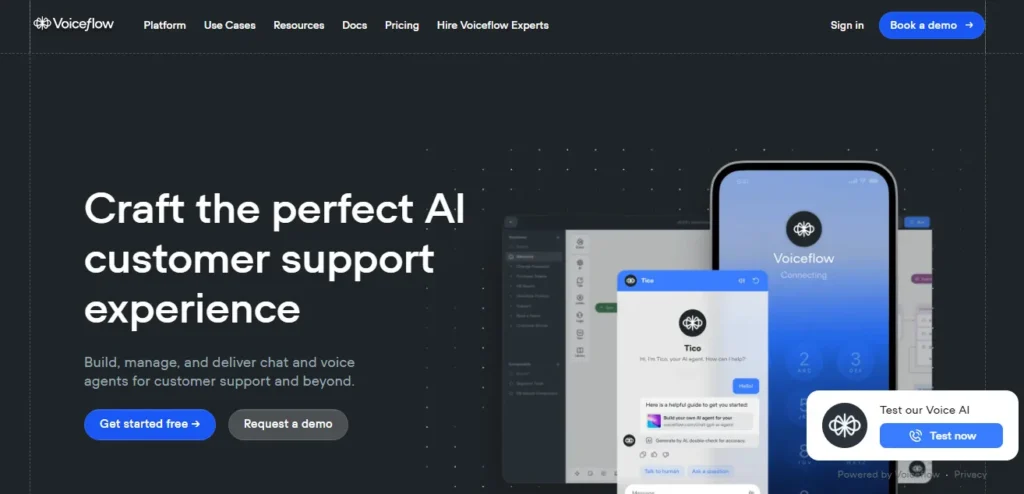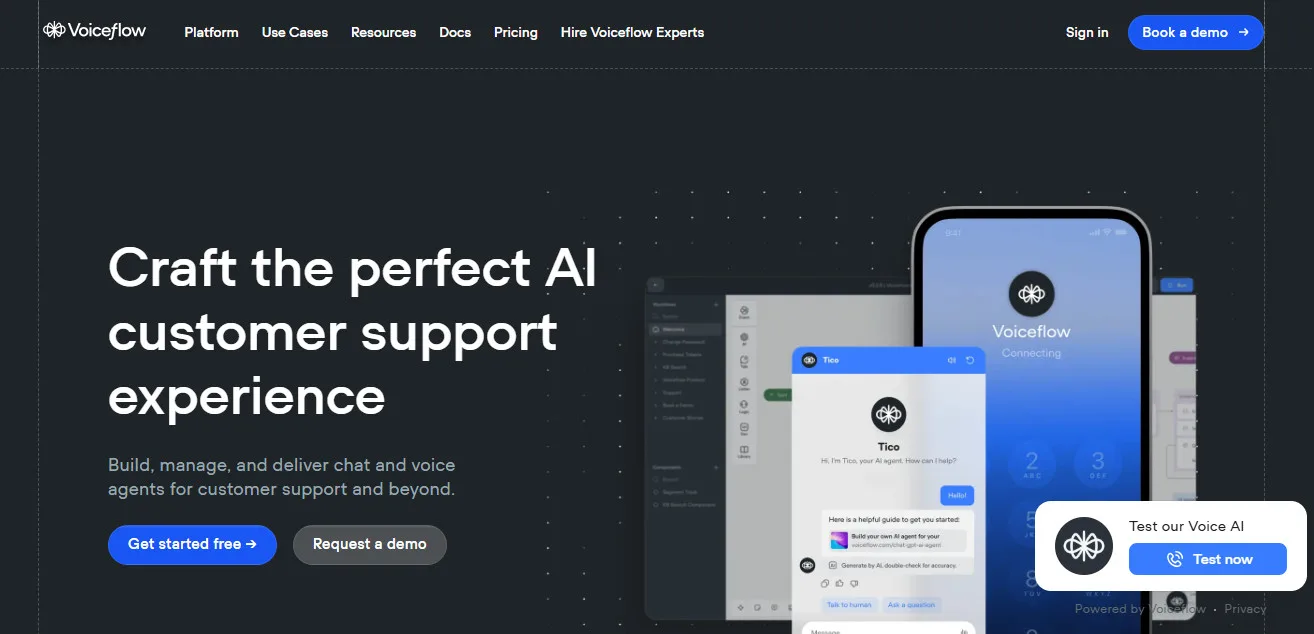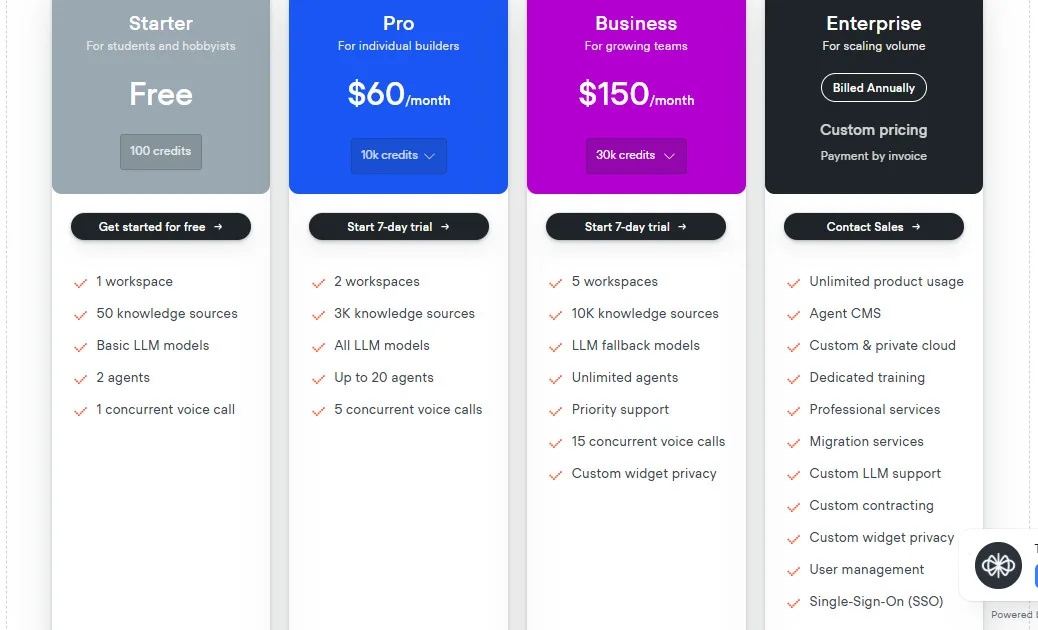In an increasingly digital-first world, the ability for businesses to engage with their customers through intelligent, automated conversations is no longer a competitive edge—it's a fundamental expectation. From answering complex support queries and guiding users through product features to automating sales processes and providing personalized experiences, conversational AI agents are revolutionizing how organizations interact with their audience.
Table of Contents
ToggleHowever, designing, developing, and deploying these sophisticated AI agents often involves a complex interplay of technical expertise, iterative design, and seamless collaboration across diverse teams. The challenge lies in finding a platform that can bridge the gap between intuitive design, powerful development capabilities, and enterprise-grade scalability.
This is precisely the challenge that Voiceflow AI is built to address. As verified directly from its official website and corroborated by extensive industry research, Voiceflow AI's primary function is to serve as a collaborative platform for teams to design, develop, and launch impactful AI Agents.
It acts as a centralized hub, empowering product teams, developers, and designers to build, test, and manage conversational AI agents at scale, regardless of the underlying AI models or integration requirements.
This platform is meticulously crafted for enterprises of all sizes, from agile startups to Fortune 500 companies, who seek to securely accelerate their AI product development, avoid vendor lock-in, and ensure controlled customization across their entire tech stack. In this comprehensive Voiceflow AI review, we will delve deep into how this innovative platform enables cross-functional teams to collaboratively create AI Agents that can talk, type, and assist customers like a human.
We will explore its unique blend of a visual Workflow Builder, a scalable Knowledge Base, multi-LLM support, and an extensible Developer Toolkit. We'll dissect its robust pros and cons, highlight its distinctive capabilities, and compare it with notable alternatives such as Synthflow AI, Vapi AI, and Voicegenie AI.
By the end of this article, you will have a clear understanding of whether Voiceflow AI is the right strategic partner to transform your conversational AI initiatives and achieve unparalleled efficiency and customer satisfaction.
What is Voiceflow?
Voiceflow AI is a leading collaborative platform designed for teams to collaboratively design, develop, and launch impactful AI Agents. Its primary function, as prominently featured on its official website, is to serve as a centralized hub for building, deploying, and scaling conversational AI experiences, whether they are text-based chatbots or voice assistants.
Voiceflow aims to empower cross-functional teams—including product managers, designers, developers, and content creators—to work together seamlessly on complex AI projects, bridging the gap between design intent and technical implementation.
The platform is built on a flexible architecture that supports integration with various Large Language Models (LLMs) and external services, allowing businesses to adapt to the rapidly evolving AI landscape without vendor lock-in. Voiceflow focuses on providing the tools necessary to create advanced AI Agents that can automate customer support, enhance user engagement, and streamline internal operations across any channel.
Key functionalities of the platform, as verified from its official website and corroborated by detailed industry reviews from 2025, include:
Visual Workflow Builder (No-Code/Low-Code): This is the core interface where teams design conversational logic.
- Intuitive Drag-and-Drop Canvas: Users can visually map out complex conversation flows using a drag-and-drop interface. This makes it accessible for designers and non-technical users to contribute to the agent's logic.
- Logic, Custom Code, and Models: The builder allows for the integration of advanced logic, custom code blocks (for developers), and direct connections to various AI models, enabling the creation of highly sophisticated and dynamic agents.
- Real-time Prototyping & Testing: Teams can test agent builds in real-time within the platform, with blocks lighting up to show the conversation path. This facilitates rapid iteration and allows stakeholders to provide feedback before deployment.
Scalable Knowledge Base & Generative AI: Voiceflow enables AI Agents to provide accurate and contextual responses by leveraging vast amounts of data.
- Data Ingestion: Users can import data and documents (e.g., website URLs, Zendesk articles, PDFs, internal documentation) into the Knowledge Base, which acts as a vector database.
- LLM-Powered Responses: Agents use this curated data, powered by integrated LLMs, to respond to complex questions, perform advanced tasks, and tailor content to specific personas.
- Content Management System (CMS): The Knowledge Base includes a CMS for organizing, managing, and scaling data sources, ensuring agents always have access to up-to-date and relevant information.
Multi-LLM Support & Vendor Agnosticism: Voiceflow provides flexibility in choosing the underlying AI intelligence.
- “Bring Your Own” LLM: Users can connect to and use any AI vendor, including leading LLMs like OpenAI (GPT-4o), Anthropic (Claude), and Google (Gemini), to power agent responses, logic, and actions. This future-proofs solutions against changes in AI technology and avoids vendor lock-in.
- LLM Fallback: A unique feature allowing automatic switching to a different LLM in case of an outage, ensuring continuous service.
Extensible Developer Toolkit & Integrations: For technical teams, Voiceflow offers powerful tools to extend agent capabilities.
- API Library: Provides a robust API library for data, knowledge, and interfaces, allowing developers to build custom integrations and extend agents to any tailored interface.
- Custom Code Blocks: Developers can insert custom code (e.g., API calls, JSON steps, JavaScript functions) directly into the conversation flow, enabling complex backend interactions and dynamic data processing.
- 300+ Integrations: Connects with a wide range of third-party services and APIs, including CRMs (Salesforce, HubSpot, Zoho CRM), customer support platforms (Zendesk, Intercom, Freshdesk), data warehouses (Snowflake), and automation tools (Zapier, Pipedream).
Enterprise-Grade Collaboration & Security: Voiceflow is built for large teams and sensitive data environments.
- Real-time Collaboration: Multiple team members can work simultaneously on the same project with shared workspaces, commenting features, and advanced user permissions (SSO support).
- Centralized Platform of Record: Acts as a secure, centralized platform for building, scaling, and managing AI products across an organization.
- Compliance: Voiceflow is SOC 2 and ISO 27001 compliant, ensuring high standards for data privacy and security.
Multi-Channel Deployment: Agents designed in Voiceflow can be launched across various channels.
- Web Chat UI: Deploy agents directly to websites using Voiceflow's embeddable web chat widget.
- Dialog API: Use the Dialog API to integrate agents into custom interfaces, mobile apps (iOS, Android), messaging platforms (WhatsApp, Telegram), and telephony systems (Twilio, Amazon Connect, Vapi).
Content Management System (CMS) for Agents: Organizes and scales all agent-related content and components in a single system, facilitating consistent messaging and efficient updates across multiple agents and use cases.
Voiceflow positions itself as the comprehensive platform for ambitious product teams to build, launch, and manage sophisticated conversational AI Agents with speed, control, and observability, ultimately transforming customer experiences and automating business processes.
How to Use Voiceflow AI Tutorial
Pros and Cons Voiceflow
Top 5 Key Features Voiceflow
Visual Workflow Builder with No-Code/Low-Code Flexibility: This is the central canvas where all AI Agent design and development takes place, making complex conversational logic accessible.
- Intuitive Drag-and-Drop Interface: Users can visually construct conversation flows by dragging and dropping blocks representing different actions (e.g., “speak,” “ask,” “API call,” “logic branch”). This intuitive interface significantly reduces the learning curve for non-technical users like designers and content creators.
- Hybrid No-Code/Low-Code Approach: While offering robust no-code capabilities, Voiceflow also provides “Code” and “Function” blocks. This allows developers to inject custom JavaScript, make direct API calls, or handle complex data manipulations, offering powerful extensibility without leaving the visual environment.
- Real-time Prototyping & Visual Debugging: As users build, they can test their agent directly within the platform. The visual builder highlights the path the conversation takes in real-time, making it incredibly easy to debug flows, identify issues, and iterate quickly.
- Example: A conversational designer drafts a customer support flow for password resets. They use drag-and-drop blocks for initial greetings, asking for user ID, and confirming details. For the actual password reset, a developer adds a “Code” block that securely calls an internal API, ensuring the sensitive action is handled programmatically.
Scalable Knowledge Base & Generative AI for Contextual Responses: This feature empowers AI Agents to provide intelligent and informed answers by leveraging vast amounts of data.
- Unified Data Ingestion: Teams can easily import diverse data sources into Voiceflow's Knowledge Base, including website URLs (sitemaps), Zendesk articles, PDFs, and other internal documents. This creates a centralized, searchable repository for the AI.
- LLM-Powered Contextual Answers: The AI Agent uses this ingested data, combined with integrated Large Language Models, to generate accurate, contextual, and human-like responses to complex user queries, moving beyond simple FAQs.
- Content Management System (CMS): The Knowledge Base includes tools to organize, segment, and manage data sources at scale. Users can preview responses, adjust LLM settings (like temperature), and fine-tune system prompts to optimize the AI's behavior and tone.
- Example: An e-commerce company trains its Voiceflow AI Agent on its entire product catalog, return policies, and shipping FAQs. When a customer asks about the warranty of a specific product or the steps for a return, the AI pulls the exact information from the Knowledge Base and provides a detailed, accurate answer.
Multi-LLM Support & Vendor Agnosticism: Voiceflow's commitment to flexibility ensures businesses are not locked into a single AI provider, allowing them to adapt to the evolving AI landscape.
- “Bring Your Own” LLM Keys: Users can connect their own API keys for leading LLMs such as OpenAI (GPT-4o), Anthropic (Claude 3.5), and Google (Gemini). This provides control over costs, allows access to the latest models, and enables leveraging specific model strengths for different parts of a conversation.
- Future-Proofing: This vendor-agnostic approach means that as new, more powerful, or more cost-effective LLMs emerge, businesses can seamlessly integrate them into their Voiceflow agents without rebuilding their entire conversational logic.
- LLM Fallback Mechanism: A crucial feature for reliability, allowing the system to automatically switch to a different LLM in case of an outage or performance degradation from the primary provider, ensuring continuous service.
- Example: A financial institution wants to use the latest, most secure LLM for handling sensitive customer inquiries, while using a more cost-effective LLM for general FAQs. Voiceflow allows them to configure different LLMs for different parts of their agent's workflow, and even sets up a fallback in case of an API issue with their primary LLM.
Enterprise-Grade Collaboration & Security: Voiceflow is designed for large teams and organizations that require robust features for secure, efficient, and scalable development.
- Real-time Team Collaboration: Multiple designers, developers, and content writers can work simultaneously on the same project within a shared workspace. Features like commenting, version control, and user permissions streamline the collaborative design and development process.
- Centralized “Platform of Record”: Voiceflow acts as a single source of truth for all conversational AI projects, ensuring consistency across agents and teams, and simplifying management at scale.
- Advanced Security & Compliance: The platform is SOC 2 and ISO 27001 compliant, providing robust data security, privacy controls, and audit trails. Features like Single Sign-On (SSO) and granular user permissions ensure secure access and control over sensitive project data.
- Example: A large enterprise has multiple product teams building AI agents. Voiceflow provides a centralized platform where each team can manage its agents, share reusable components, and ensure all development adheres to corporate security and compliance standards, with IT having full oversight via SSO and detailed permissions.
Extensive Integration Capabilities via Developer Toolkit: Voiceflow's flexibility allows AI Agents to connect with virtually any external system, extending their functionality beyond mere conversation.
- Robust API Library: Provides a comprehensive API for interacting with agent data, knowledge, and interfaces. Developers can use this to build custom front-ends, integrate with proprietary backend systems, or push/pull data dynamically.
- Webhooks & Custom Code Blocks: Agents can trigger webhooks to send data to external applications (e.g., CRMs, analytics platforms) or receive data from them. Custom code blocks allow for direct interaction with external APIs (e.g., fetching real-time inventory, booking appointments in a third-party system).
- Pre-built Integrations: Voiceflow offers pre-built connectors for popular tools like Zendesk, Salesforce, HubSpot, Zoho CRM, Segment, and Snowflake, simplifying common integrations for customer support, sales, and data analytics.
- Multi-Channel Deployment: Beyond web chat, agents can be deployed to voice channels (via Twilio, Amazon Connect, Vapi), mobile apps (iOS, Android), and messaging platforms (WhatsApp, Telegram) by leveraging its robust API and integrations.
- Example: A retail company uses a Voiceflow AI chatbot on its website. When a customer asks about order status, the AI uses an API call (via a custom code block) to the company's order management system, retrieves the real-time status, and provides it to the customer. If the customer then requests a return, the AI triggers a webhook to create a return ticket in Zendesk.
Who Should Use Voiceflow AI?
Voiceflow AI's unique blend of visual design, powerful development capabilities, and collaborative features makes it an ideal solution for a wide range of professionals and organizations focused on building and scaling conversational AI.
Ideal Users:
Product Managers & Owners: To quickly prototype, design, and manage the lifecycle of AI Agents, ensuring they align with business goals and user needs, and to facilitate collaboration across teams.
Conversational Designers: The visual workflow builder is perfect for designing complex dialogue flows, managing intents, and ensuring a natural and effective conversational experience.
AI/ML Engineers & Developers: To integrate custom code, leverage advanced LLMs, connect to backend systems via APIs/webhooks, and extend the platform's capabilities for highly specific use cases.
Customer Support Teams & Leaders: To automate tier-1 and tier-2 support inquiries, provide 24/7 assistance, and intelligently route complex issues to human agents, reducing ticket costs and improving resolution times.
Marketing & Sales Teams: For building AI agents that can qualify leads, answer product FAQs, guide users through sales funnels, and provide personalized information.
Enterprises & Large Organizations: Companies requiring a secure, centralized platform for building and managing a portfolio of AI Agents across different departments, with robust collaboration, access control, and compliance features (SOC 2, ISO 27001).
Agencies & Consultancies: To design and deliver conversational AI solutions for their clients, leveraging Voiceflow's flexibility and collaborative features for efficient project management.
E-commerce Businesses: To automate customer service inquiries (e.g., order status, returns), provide product recommendations, and enhance the online shopping experience through intelligent chatbots.
Uncommon Use Cases:
Internal Employee Support Bots: Building AI agents to answer common HR, IT, or internal policy questions, streamlining internal operations and reducing the burden on support staff.
Interactive Training & Onboarding: Creating AI-powered guides that can walk new employees or customers through complex processes, providing interactive explanations and answering questions in real-time.
Content Curation & Information Retrieval: Developing AI agents that can query internal knowledge bases or external sources (e.g., news APIs) and synthesize information for users on demand.
Personalized Learning & Tutoring Bots: Creating AI tutors that adapt to a student's learning style, answer questions, and provide explanations on various subjects.
Voice-Activated Smart Home/IoT Control: Designing conversational interfaces for smart devices or IoT systems, allowing users to control them through natural language commands.
Accessibility Tools: Building conversational AI interfaces that make digital content and services more accessible for individuals with disabilities, allowing interaction via voice or simplified chat.
Gaming & Interactive Entertainment: Developing narrative-driven games or interactive experiences where AI agents serve as characters or guides, responding dynamically to player input.
Voiceflow Pricing
Voiceflow offers a range of plans tailored for students, hobbyists, individual builders, and growing teams:
Starter (Free – For students and hobbyists): This plan provides 100 credits. It includes 1 workspace, 50 knowledge sources, basic LLM models, 2 agents, and 1 concurrent voice call.
This is a great way to begin exploring AI voice projects! If you're looking to try it out or support us, consider starting your plan today!
Pro ($60/month – For individual builders): This plan comes with 10,000 credits. It includes 2 workspaces, 3,000 knowledge sources, all LLM models, up to 20 agents, and 5 concurrent voice calls.
For individual creators looking for more robust tools, this plan offers significant upgrades. If this plan suits your needs, we'd appreciate it if you free signed up here!
Business ($150/month – For growing teams): This plan offers 30,000 credits. It provides 5 workspaces, 10,000 knowledge sources, LLM fallback models, unlimited agents, 15 concurrent voice calls, and custom widget privacy.
If you're managing a growing team, this plan provides the capacity and features you need for collaborative projects. If you choose this plan, consider supporting us when you make your purchase!
Enterprise (Custom pricing – For scaling volume): This plan is designed for scaling volume and offers custom pricing with payment by invoice. It includes unlimited product usage, Agent CMS, custom & private cloud, dedicated training, professional services, migration services, custom LLM support, custom contracting, custom widget privacy, user management, and Single-Sign-On (SSO).
Contact sales to discuss a tailored solution for your large-scale needs! If you're considering this enterprise solution, reaching out would be a great way to support our work!
Disclaimer: Pricing details may change. Visit the official Voiceflow website for the latest information.
What Makes Voiceflow AI Unique?
Voiceflow AI distinguishes itself in the crowded conversational AI market through its strategic combination of design-first principles, developer flexibility, and enterprise-grade collaboration.
Design-to-Deployment Centralization: Unlike tools that are purely for design or purely for development, Voiceflow serves as a “platform of record” that centralizes the entire lifecycle of an AI Agent—from initial design and prototyping to development, testing, launch, and ongoing management. This holistic approach significantly streamlines workflows and reduces friction between different teams.
True Visual-Code Hybridity: Many platforms claim “no-code,” but Voiceflow genuinely empowers both non-technical designers and seasoned developers. The visual builder is intuitive for flow design, while the integrated “Code” and “Function” blocks provide developers with the full power of custom logic and API integrations, ensuring no feature gaps. This hybridity is a key differentiator, allowing for both rapid prototyping and deep customization.
Unwavering LLM Agnosticism: Voiceflow's commitment to supporting any LLM (including BYO keys) sets it apart. This means businesses can always leverage the latest and most suitable AI models without being locked into a single vendor's ecosystem, future-proofing their investments in conversational AI.
Focus on Scalable Knowledge Base for Generative AI: While many platforms offer knowledge bases, Voiceflow emphasizes building a scalable vector database that can handle thousands of data sources. This, combined with generative AI, allows for highly accurate, contextual, and dynamic responses to complex queries, crucial for enterprise-level customer support.
Collaboration as a Core Feature: Voiceflow isn't just a tool; it's a collaborative workspace. Real-time editing, commenting, version control, and granular permissions ensure that large, cross-functional teams can work together seamlessly, accelerating development cycles and improving agent quality.
High-Fidelity Prototyping & Testing: The ability to test agents in real-time within the visual canvas, with blocks lighting up to show the conversation path, provides an unparalleled prototyping experience. This allows for quick iteration and stakeholder feedback, drastically reducing time-to-market.
These unique attributes position Voiceflow AI as a comprehensive, flexible, and collaborative platform that empowers organizations to build, launch, and scale advanced conversational AI Agents efficiently and securely.
Voiceflow Compatibilities & Integrations
Voiceflow AI is built with an extensive and flexible integration architecture, allowing it to seamlessly connect with a wide array of AI models, external applications, and deployment channels. Its core strength lies in its API-first approach, complemented by a user-friendly interface.
Web-Based Platform: The primary Voiceflow workspace is a web-based application, accessible via any modern browser, ensuring broad compatibility across all operating systems (Windows, macOS, Linux) and devices.
Input Types:
- Text & Visual Flow Design: Users input text for prompts, responses, and logic within the visual builder.
- Custom Data Sources: For the Knowledge Base, users can import data from:
- Website URLs (sitemaps)
- PDF documents
- Zendesk articles
- Other internal documentation.
- API/Webhook Data: Can receive real-time data and triggers from external systems via its API or webhooks to inform conversations or initiate actions.
- Speech/Text Input from Channels: Processes user input from various channels (web chat, voice calls, messaging apps).
Output Types:
- Conversational Responses: Delivers text-based chat responses or synthesized voice responses.
- API/Webhook Calls: Triggers actions in external systems by sending data via API calls or webhooks.
- Analytics Events: Can send interaction data to analytics platforms.
- Transcripts/Logs: Generates logs of conversations for review and analysis.
Core AI Model Integrations (BYO Keys):
- Large Language Models (LLMs): Integrates with leading LLM providers, often allowing users to “Bring Your Own” API keys for:
- OpenAI (GPT-3.5, GPT-4o, etc.)
- Anthropic (Claude 3.x)
- Google (Gemini)
- Llama (various versions)
- Other custom LLMs.
- Speech-to-Text (STT) & Text-to-Speech (TTS): While often tied to the LLM provider or underlying telephony integration, Voiceflow supports high-quality voice synthesis and recognition.
Third-Party Application Integrations (via API, Webhooks, Functions):
- CRM Systems: Connects with popular CRMs for lead qualification, contact management, and data synchronization:
- Salesforce
- HubSpot
- Zoho CRM
- Close CRM
- Pipedrive
- Customer Support Platforms: Integrates with helpdesk and ticketing systems:
- Zendesk
- Intercom
- Freshdesk
- Data Warehouses & Analytics: For advanced data analysis and reporting:
- Snowflake
- Segment
- Google Analytics
- Workflow Automation: Connects with iPaaS (Integration Platform as a Service) tools for complex multi-app workflows:
- Zapier
- Pipedream
- Make.com
- Communication & Collaboration Tools:
- Slack
- Microsoft Teams
- Telegram
- WhatsApp (via third-party connectors)
- Scheduling & Calendar Tools:
- Calendly
- Google Calendar
- E-commerce Platforms: Integrations for order tracking, product information, etc.:
- Shopify
- Content Management Systems (CMS):
- WordPress
- Drupal
- Telephony Integrations: For voice agent deployment:
- Twilio
- Amazon Connect
- Vapi AI
- Plivo
Developer Toolkit & SDKs:
- REST API: Comprehensive API for programmatic control over agents, conversations, and data.
- Client SDKs: For embedding agents into custom front-ends (e.g., React, Next.js).
- Custom Code/Function Blocks: Allows developers to write custom JavaScript directly within the visual builder for highly specific logic or API calls.
Deployment Channels:
- Web Chat Widget: Embeddable widget for websites.
- Custom Interfaces: Deployable to any custom interface via the Dialog API.
- Voice Channels: Through integrations with telephony providers.
- Messaging Platforms: Via custom integrations (e.g., WhatsApp, Telegram).
Security & Compliance:
- SOC 2 Type II Certified: Ensures robust internal controls over data security.
- ISO 27001 Certified: Adheres to international standards for information security management.
- GDPR Compliant: Ensures compliance with European data protection regulations.
- SSO & User Permissions: Advanced features for secure access and team management.
Voiceflow's extensive integration capabilities make it a highly versatile tool that can seamlessly fit into and enhance virtually any existing business technology stack, enabling the creation of powerful, interconnected AI Agents.
How We Rated It Voiceflow
3 Top Voiceflow AI Alternatives
Looking for Voiceflow alternatives? Please Check out below Top 3 Voiceflow AI alternatives options to consider:
Synthflow AI Best for Conversational Voice Bot Design
Vapi AI Best for API-Based Voice Assistant Development
Voicegenie AI Best for Phone-Based AI Voice Calls
Each alternative offers unique features that might better suit your specific needs. Consider your primary use case, budget, and required features when choosing between these options.
Summary Voiceflow AI Review
Voiceflow AI stands as a highly innovative and robust collaborative platform for teams to design, develop, and launch impactful AI Agents, encompassing both chat and voice functionalities. Its primary strength lies in serving as a centralized hub that seamlessly blends an intuitive visual Workflow Builder with a powerful Developer Toolkit, empowering cross-functional teams to create sophisticated conversational AI experiences at scale.
The platform excels in its multi-LLM support, allowing users to leverage and switch between leading AI models while avoiding vendor lock-in. Its scalable Knowledge Base enables agents to provide accurate, context-aware responses by training on vast amounts of custom business data. Furthermore, Voiceflow's enterprise-grade collaboration and security features (SOC 2, ISO 27001, SSO) make it an ideal choice for large organizations with complex needs.
While the per-editor pricing model might be a consideration for very large teams, and advanced features require a learning curve, its overall value proposition for accelerating AI product development and reducing total cost of ownership is compelling.
Compared to alternatives like Synthflow AI (no-code voice automation), Vapi AI (API-Based Voice Assistant Development), and Voicegenie AI (Phone-Based AI Voice Calls), Voiceflow AI carves out a distinct niche by offering a holistic, collaborative, and highly flexible environment for designing, building, and deploying AI Agents across diverse channels.
For ambitious product teams and enterprises seeking to securely build, test, and manage cutting-edge conversational AI solutions, Voiceflow AI provides the comprehensive and adaptable platform needed to succeed.
Voiceflow FQA:
What is Voiceflow AI's primary function?
Voiceflow AI's primary function is to be a collaborative platform for teams to design, develop, and launch impactful AI Agents (chat and voice), serving as a central hub for building and scaling conversational AI experiences.
Do I need coding skills to use Voiceflow AI?
Voiceflow AI offers a no-code visual Workflow Builder for easy design, but it also provides a powerful Developer Toolkit with custom code blocks and APIs, allowing developers to extend functionality with code.
Can Voiceflow AI integrate with different LLMs?
Yes, Voiceflow AI supports multi-LLM integration, allowing users to connect and use any AI vendor, including OpenAI, Anthropic, and Google Gemini, and even “Bring Your Own” LLM keys.
How does Voiceflow AI use my business data?
Voiceflow AI features a scalable Knowledge Base where you can import data (websites, PDFs, Zendesk articles) to train your AI Agent, enabling it to provide accurate and contextual responses to user queries.
Is Voiceflow AI suitable for large teams and enterprises?
Yes, Voiceflow AI is designed for enterprise use, offering real-time collaboration, advanced user permissions, SSO, and SOC 2/ISO 27001 compliance for secure and scalable development.
Can Voiceflow AI agents be deployed on different channels?
Yes, agents built on Voiceflow can be deployed across web chat, mobile apps, messaging platforms, and voice channels (via integrations with telephony providers like Twilio or Vapi).
Does Voiceflow AI offer prototyping and testing features?
Yes, Voiceflow AI provides high-fidelity prototyping and real-time testing within its visual builder, allowing teams to simulate conversations and iterate quickly.
What kind of integrations does Voiceflow AI support?
Voiceflow AI offers extensive integrations via its API and webhooks, connecting with CRMs (Salesforce, HubSpot), customer support platforms (Zendesk), data warehouses (Snowflake), and workflow automation tools (Zapier).
What are the main benefits of using Voiceflow AI?
Key benefits include accelerated AI product development, reduced total cost of ownership, enhanced team collaboration, flexible LLM integration, and the ability to build highly customized and scalable conversational AI agents.
Does Voiceflow AI have a free plan?
Yes, Voiceflow AI typically offers a free plan with limited features, allowing users to get started and explore the platform.
Did you find this content helpful?




















